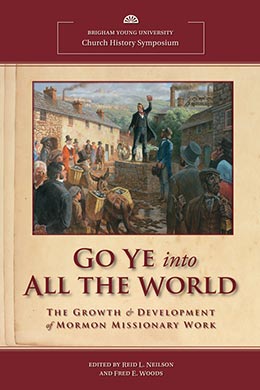The Mission of the Kyiv Ukraine Temple
Kahlile B. Mehr
Kahlile B. Mehr, "The Mission of the Kyiv Ukraine Temple," in Go Ye into All the World: The Growth and Development of Mormon Missionary Work, ed. Reid L. Neilson and Fred E. Woods (Provo, UT: Religious Studies Center, 2012), 543–55.
Kahlile B. Mehr was Slavic Collection manager for FamilySearch when this book was published.
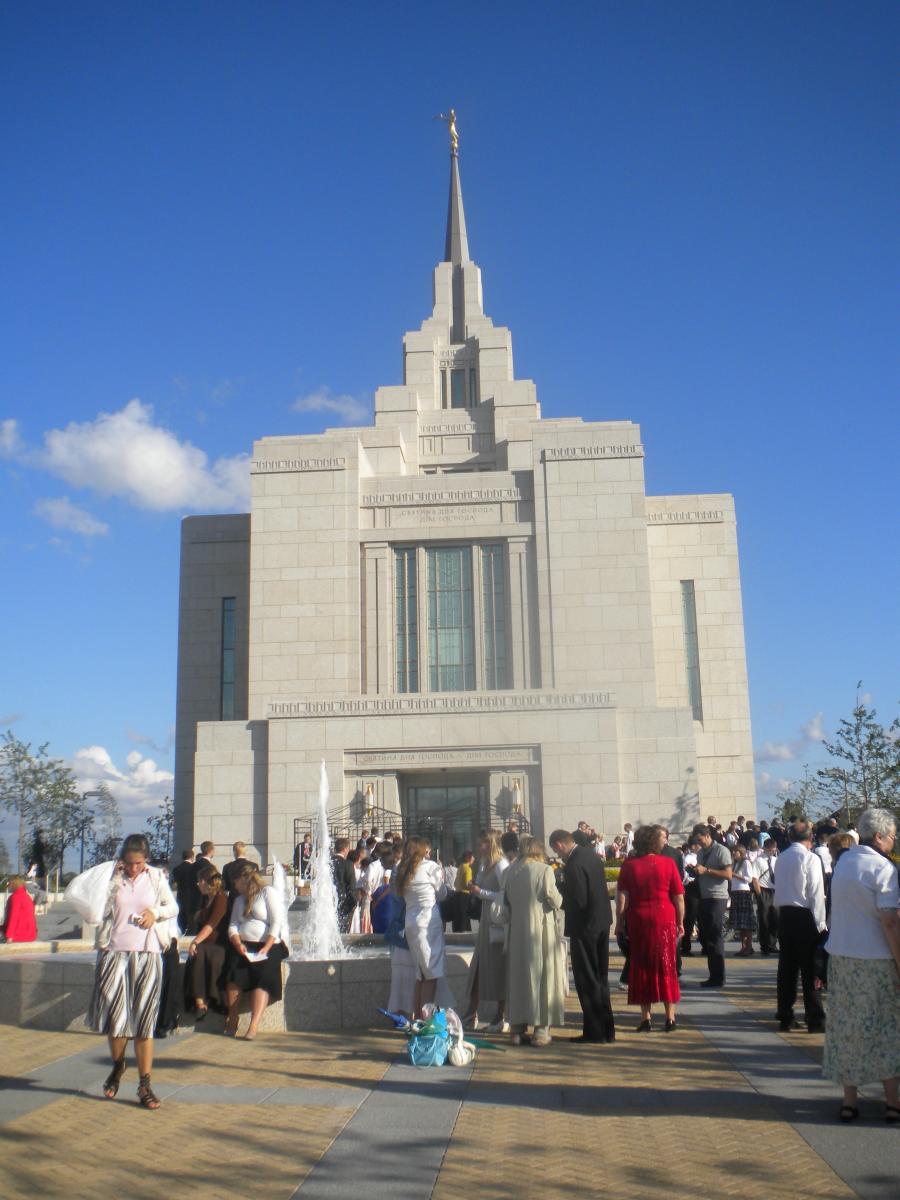 Kyiv Ukraine Temple after its dedication Sunday, August 29, 2010. All images courtesy of Kahlile B. Mehr unless otherwise noted.
Kyiv Ukraine Temple after its dedication Sunday, August 29, 2010. All images courtesy of Kahlile B. Mehr unless otherwise noted.
The Kyiv Ukraine Temple represents a departure from the more recent historical sequence of temple building. The temple was announced eight years after missionaries entered Ukraine and was dedicated within twenty years. It ranks with Kirtland and Nauvoo in terms of time between the introduction of the gospel and the opening of the Church’s most sacred edifice. [1] Unlike other temples erected long after congregations and leadership have been established, the Ukraine temple was erected in the early stages of the missionary effort. This suggests that temples are destined to play an increasingly important role in taking the gospel message to the living. While temples have always contributed to missionary work, they are now contributing to this work as the Church establishes its presence in a country or region. It is a milestone not only in temple building but also in the evolution of the Church’s spread throughout the world. This paper is an effort to show the role of the Kyiv temple in establishing the Church in Ukraine, in contrast to the more recognizable role of the Church establishing the Kyiv temple, for the mission of the Kyiv temple is to bring the gospel out of obscurity in this world as well as in the next.
A simple division of the LDS population in a country by the number of temples worldwide produces a ratio of temples per members. Using this formula for 2009, Ukraine ranked thirty-fifth among the thirty-nine countries and territories that already had a temple at one temple per eleven thousand members. Those ranked below Ukraine were Denmark, Finland, Switzerland, Netherlands, and Sweden. Adding the memberships of all nine countries belonging to the Kyiv Ukraine Temple District raises the ratio to one temple per thirty-nine thousand members, putting it above Fiji, Germany, Tahiti, Hong Kong, Australia, Canada, and Costa Rica. [2] The Church entered most of these countries [3] in the nineteenth century, whereas the Church first entered Ukraine in 1990. Thus the Kyiv temple was constructed at the beginning of the missionary work in that country.
Even more startling with regard to time frame is that there were just over five thousand members among the forty million Ukrainians when President Gordon B. Hinckley announced in 1998 that a temple would be built there. Temples existed in only twenty-three countries at that date. European temples were located in Switzerland, England, Germany, and Sweden; all of these countries had stakes and centuries of Church presence. It was a breathtaking moment to anyone who considered the circumstances of this nascent outpost far outside the traditional domain of the Church’s presence. The Church had but a single chapel in Ukraine, dedicated in Donetsk just weeks before the temple announcement. [4] It would be another six years before the Church organized a stake in Kyiv. When the temple was announced, the members were relatively inexperienced, and the Church’s leadership was not very deep. It seems, then, that the temple served to establish the Church rather than the other way around, as had been the case with temple building historically.
Temples Serve the Living in Two Ways
The primary reason for building temples in areas of limited Church membership is not that they will grow the Church. President Hinckley announced the Kyiv Ukraine Temple at the front end of an unprecedented expansion of temple building at the end of the twentieth century for the purpose of “taking the temples to the people.” [5] As President Hinckley announced in October 1997 general conference, “There are many areas of the Church that are remote, where the membership is small and not likely to grow very much in the near future. Are those who live in these places to be denied forever the blessing of the temple ordinances?” The answer is, “We will construct small temples in some of these areas.” [6] Through 1998, the greatest number of temples dedicated in a single year was six. Unprecedented then and unequaled since is the dedication of fifteen temples in 1999 and thirty-four in 2000. During the next decade, only thirty-two additional temples were dedicated, the last being Kyiv. The primary reason to build temples, then, was to provide temple blessings to worthy members worldwide. Aligned with this concept are the words of President Spencer W. Kimball that President Thomas S. Monson quoted at the laying of the cornerstone in Kyiv. There is no greater statement in the history of the Church than this: “‘If you can’t gather the people closer to the temple, bring the temples to the people.’” [7] The announcement of the Kyiv Ukraine Temple symbolized to members that the Church was in the country to stay and that it was committed to ensuring that every blessing was available to them just as it would be available to any other member elsewhere in the world. [8]
In addition to the temple’s role in serving the members, its role in an area of limited Church membership is to be as great a missionary tool as any at the Church’s disposal. There is no better example of this than the Freiberg temple built in East Germany when it was still part of the Soviet Bloc. In 1985, the Communist grip on Eastern Europe seemed absolute, with little hope of establishing the Church in Communist countries. This changed after the construction of the temple. The temple’s influence has been noted by a Church leader who was intimately involved in the growth of the Church in Eastern Europe throughout the period. Elder Dennis Neuenschwander said, referring to the Freiberg temple, “The temple became a standard, a light, and whenever there is a temple, there is additional power and enlightenment and spirituality.” [9] Within two years of the dedication, young missionaries entered Hungary, the next year Poland, and in the fourth year East Germany and the Soviet Union.
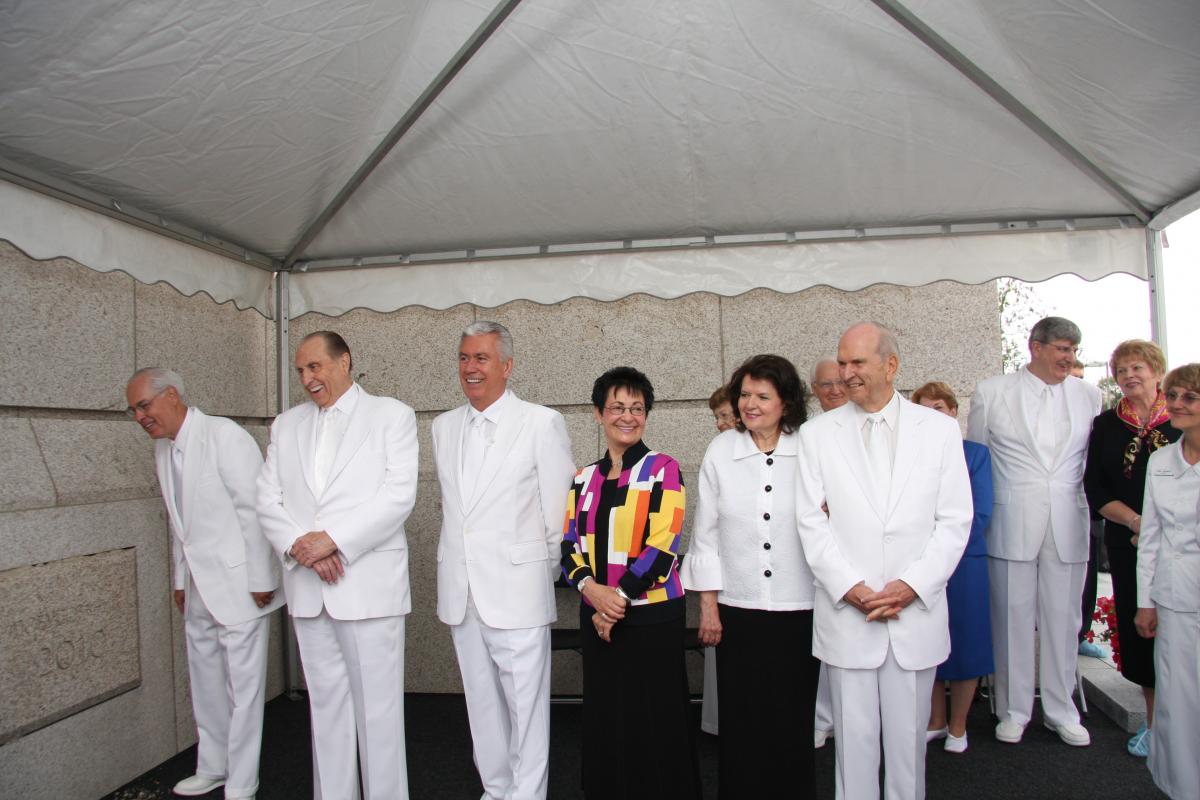 Left to right: Elder William R. Walker of the Seventy, President Thomas S. Monson, President Dieter F. Uchtdorf, Sister Harriet Uchtdorf, Sister Wendy L. Nelson, and Elder Russell M. Nelson at the cornerstone ceremony of the Kyiv Ukraine Temple, August 2010. Photograph by Gerry Avant, © Deseret News.
Left to right: Elder William R. Walker of the Seventy, President Thomas S. Monson, President Dieter F. Uchtdorf, Sister Harriet Uchtdorf, Sister Wendy L. Nelson, and Elder Russell M. Nelson at the cornerstone ceremony of the Kyiv Ukraine Temple, August 2010. Photograph by Gerry Avant, © Deseret News.
Commenting on the ninety thousand people who came through the two weeks of the Freiberg Temple open house, Marianne Nikol observed that the visitors infected one another with their curiosity without any intervention of the members. [10] Erich Dzierzon witnessed many Germans who came to Freiberg out of curiosity become interested in the Church, leading to many baptisms in Freiberg thereafter. Garold Davis, who served a mission in East Germany from 1989 to 1990, noted that they baptized many people who had their first contact with the Church at the temple. Manfred Schwabe, who was serving as a stake missionary at the time of the open house, commented that as a result of the open house, they had thousands of people interested in learning more. In a meeting of Church leaders with the legal counsel from East Germany held November 1, 1985, the counsel stated that had the government known two years earlier the stir the construction of a temple would have occasioned among the population, permission would never have been given to build such a facility. [11]
The northwestern portion of the former Soviet Union became part of the Helsinki Finland Temple District in 2006, leaving the Stockholm Sweden Temple District, to which district Russians had belonged since the early 1990s. The open house and dedication there had a powerful effect on many visitors, as these things did in Freiberg. After a visit during the open house, one Russian commentator, well known as an atheist, said, “In our [cathedrals], in Russia, it’s dark, and you’re made to feel like you’re small, and that you’re dark and alone, and that you’re nothing. You walk into this temple and all of a sudden you see that everything is well defined, that there is a purpose, and that man has potential to become something much greater than he could ever imagine himself.” [12] After the dedication, “all of a sudden, it was [as] though a spigot was turned on of religious scholars and others writing accurate and positive things about the Church.” [13]
The temple in Ukraine serves members there, as well as in eight surrounding countries. It was chosen as a temple site not only because of its location but also because of its membership growth. Among Eastern European countries, Ukraine had the highest ratio of conversions per missionary during the 1990s. In 1998, when the temple was announced, there were 5,200 members there, second in Eastern Europe only to Russia with 8,800 members. [14] At that date, there were two missions in Ukraine and eight in Russia. This growth pattern was evident to Church authorities when Elder Dallin H. Oaks visited Ukraine in March 1994. He recollects, “While on my feet, I felt impressed to say to these people that at the rate of growth they had established and with the remarkable people they are . . . they were likely to see a House of the Lord, a temple, in Ukraine in their lifetime.” [15] Toward the end of the period from 1990 to 2009, the conversion ratio began to decline. For those two decades, Ukraine had 0.26 converts per missionary in an average month compared to 0.18 for the rest of Eastern Europe. The ratio for the last three years of the decade dropped to an average of 0.07 for 2007 to 2009. [16] This decline is currently being reversed. From November 2010 to January 2011, Ukraine returned to a 0.13 average. For Ukraine, the increase is in direct proportion to the distance from the temple, with the greatest percentage increase in baptisms being performed in the Kyiv Mission, then in Dnipropetrovsk in central Ukraine, and then in Donetsk in eastern Ukraine. [17] These are preliminary findings and are by no means conclusive evidence of a causal relationship between the temple dedication and membership increase. More time and additional evidence ought to clarify the temple’s role.
Preparations for the Kyiv Temple
In 2002, President Gordon B. Hinckley visited Ukraine and selected the site for a temple. The decision was kept confidential to avoid any undesirable publicity. The site was along the circle highway surrounding Kyiv and outside the city limits. In the efforts to obtain a site for the previous four years, the Church had failed to gain the confidence of the city officials. The county officials were more supportive. Still, the Church did not rush the construction, waiting for the membership to grow sufficiently to establish a stake. Anticipating that day, the local leadership was trained monthly for a year in the skills required to run a stake. In September 2003, Elder Russell M. Nelson visited Ukraine. The apostolic point of contact for Eastern Europe at the time, he decided the time had come to proceed with the creation of a stake. The application to create a stake was approved in less than a month. [18] In May 2004, the Church established the Kyiv Ukraine Stake.
One of the early concerns before the stake was approved was whether the temple could be staffed locally. The membership was youthful, with many commencing their careers and families. Those more advanced in years generally worked until unable to do so, retirement being virtually a nonexistent option. In August 2010, there was a deficit filled by expatriate missionaries (18), while the majority of the temple staff was local (23). Additionally, in January 2011, there were 222 set-apart temple workers—impressive in comparison with the Church population. [19] Hence, though there is but a single stake in the temple district, the operation of the temple is being well supported by the local members.
The temple groundbreaking occurred in June 2007. By direction of the First Presidency, in order to avoid any counterproductive publicity, the groundbreaking was not announced. The groundbreaking was brief and the gathering small. After the dedicatory prayer, a nonmember scholar writing a book about the Church in Ukraine said, “Going through the temple in Helsinki was a great experience, but this was a powerful experience. This was an ordinance and I could feel that it was an ordinance.” [20]
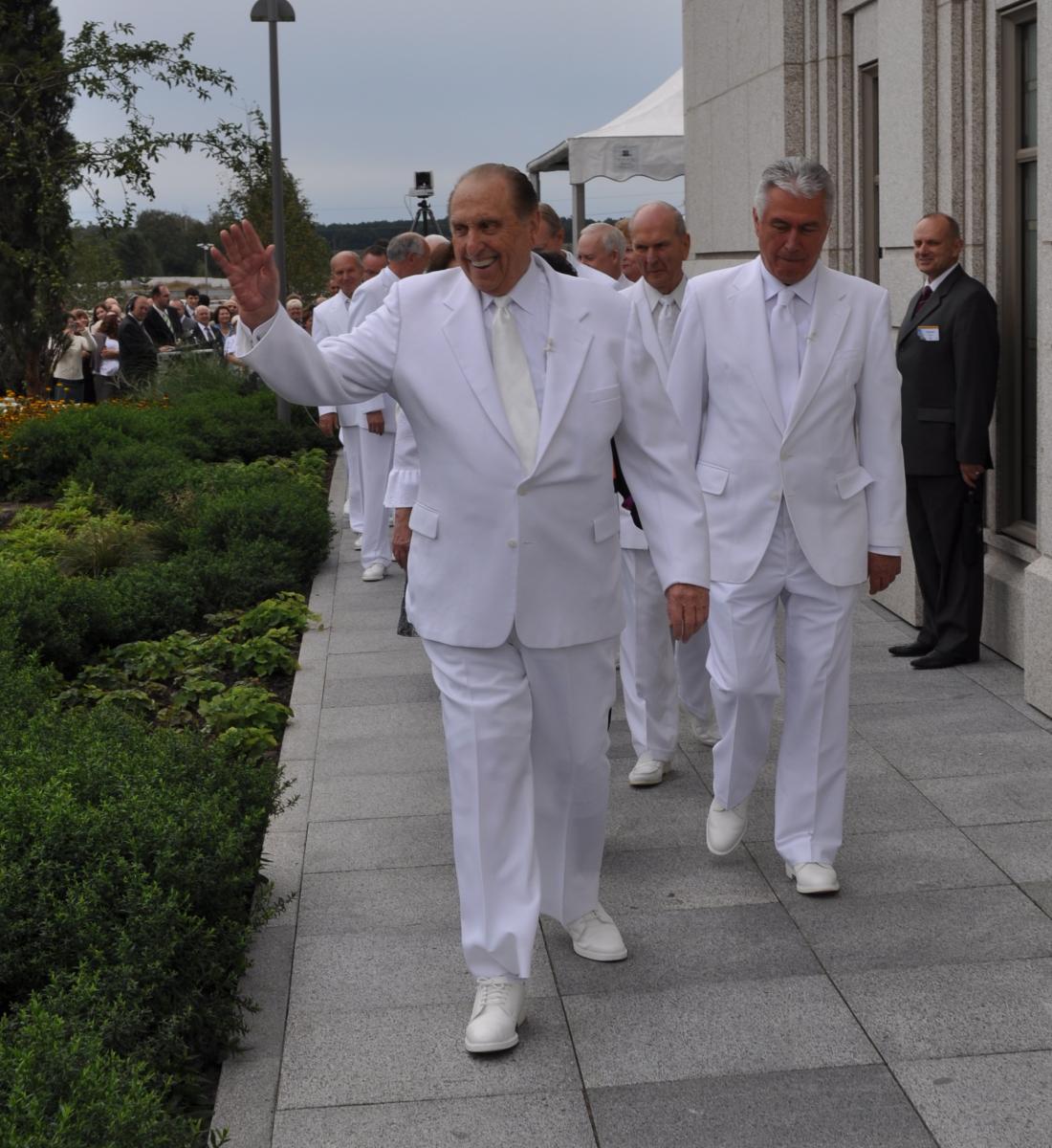 President Thomas S. Monson waving at the cornerstone ceremony of the Kyiv Ukraine Temple, August 2010. Speaking of the Kyiv temple, President Monson said, "It shines as a beacon of righteousness to all who will follow its light." Photograph by Scott Taylor, © Deseret News.
President Thomas S. Monson waving at the cornerstone ceremony of the Kyiv Ukraine Temple, August 2010. Speaking of the Kyiv temple, President Monson said, "It shines as a beacon of righteousness to all who will follow its light." Photograph by Scott Taylor, © Deseret News.
When the angel Moroni was hoisted to the pinnacle of the Kyiv temple on September 21, 2010, it heralded the restored gospel being taken to all of Eastern Europe.[21] This statement recognizes the purpose of temples to spread the message of the Restoration—the proselytizing purpose of temples as opposed to that of simply serving the membership. At the cultural celebration held on the eve of the dedication, President Monson spoke not of the temple’s purpose with regard to the dead but of its purpose for the living, saying, “It shines as a beacon of righteousness to all who will follow its light.”[22]
The temple’s power to convert is seen in the life of Alexander N. Manzhos, the first Ukrainian called as an Area Authority Seventy. At the groundbreaking of the Kyiv Ukraine Temple, he related the conversion of his wife after he had experienced the temple. He explained how they could be sealed, extending their love and companionship into eternity. This turned the key to her heart.[23] Temple open houses touch those not yet members of the Church. Comment cards left by attendees attest to the spirit they feel there. Of those submitting comments cards in Kyiv, 25 to 30 percent have asked for missionaries to teach them more.[24]
Historical and Personal Reflections on the Kyiv Temple
When Elder Boyd K. Packer pronounced an apostolic blessing upon Ukraine on September 12, 1991, soon after the commencement of missionary work there, he did so at the base of a monument honoring Volodymyr (or Vladimir in Russian), grand prince of the Kievan Rus. A millennium earlier, Volodymyr, a convert to Christianity, had forced its adoption by his subjects. From his capital at Kyiv (Kiev in Russian), Christianity spread throughout the Slavic world in Eastern Europe.[25] Hence, the restored gospel of Christ, symbolized by the Kyiv temple, commenced at the place where the gospel of Christ taught anciently first touched the Slavic world. It is perhaps no accident that the main boulevard of Kyiv is called Kreshchiatik, which translates into English as “baptism,” the initial Christian ordinance of salvation. It may not be a coincidence that the patron saint of Kyiv is the Archangel Michael, supreme warlord of celestial forces, known during his mortal life as Adam. Being the first man, he stands at the head of the human family and the patriarchal order, so central to the purpose of the temple.
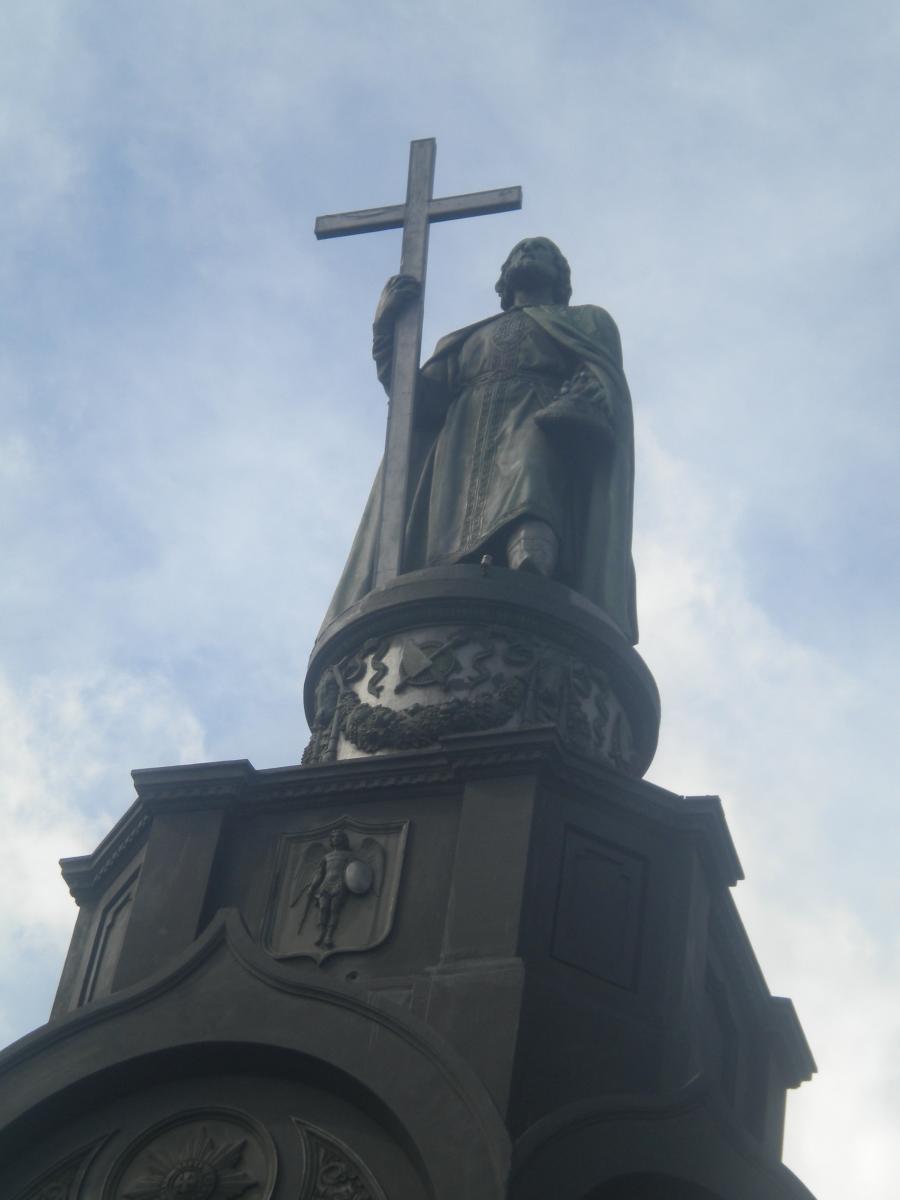 Statue of Volodymyr in Kyiv, Ukraine, Courtesy of the author.
Statue of Volodymyr in Kyiv, Ukraine, Courtesy of the author.
The power of the new life generated by the gospel message is reflected in the two main architectural design motifs of the temple—a staff of wheat and a decorated Easter egg.[26] Ukraine’s rich soil has historically provided vast stores of wheat. The yellow half of the Ukrainian flag represents the wheat; and the blue half represents the sky from which the wheat receives light to grow. Elder Dieter F. Uchtdorf commented on the day of dedication that “Ukraine was once the ‘breadbasket of Europe;’ it supplied the other countries with wheat. You could say that it will now be the spiritual breadbasket because of the temple.”[27] The Easter egg symbolizes the Resurrection and Atonement of Christ, inspiring reflection upon these supernal events.
The temple is three stories high, an exception in the era of smaller temples. The temple site is prominent on the circle highway that encompasses western Kyiv from the north to the south. Driving from the north, the temple rises majestically in front of the motorist for some time before it is passed. It has much the same impact as the Washington D.C. Temple. The height of the temple was dictated by the Church.[28] The temple bears a striking similarity to the Golden Gate of Kyiv, the only surviving gate of the original wall surrounding Kyiv, a place of passage between the world and the city; this might be seen in temple terms as the passage between this world and the next. The height certainly attracts attention and possible interest among the living to learn more about the building, its purpose, the gospel, and the Church.
The casual observer may miss some of the design features that contribute to the overall impact of the temple to the eye. The exterior surface is Amarelo Macieira granite from Portugal. It was selected because it provides a warm look. The granite contains quartzite crystals that reflect sunlight. The color of the stone changes subtly during the day as the sun passes across the sky. While the exterior is all of the same granite, it has different finishes to give the temple a varied look.[29] While these visual details do not have any intended religious significance, they do suggest the warmth of the gospel message and how its light touches each life differently.
There is another instance in which the Kyiv temple is a harbinger of gospel light. Temple file names on hand when the temple opened were extracted by Church members in Ukraine and Russia from the historical church records of the Kyiv area. It was the first use of FamilySearch Indexing for this purpose. It is also the first instance in which temple file names were delivered in Cyrillic text. Hence, the first temple in the Slavic world opened with Slavic names rendered in their native script.
As a participant in the dedicatory service, the cultural event that preceded it, and the first ordinance session on Monday, I offer a few observations about the mission of the temple. At the cultural event, President Monson spoke to the youth, saying that gathering them together helped them to feel part of a group and not alone in their distant units. This emphasizes the mission of the temple to the living in this “pioneer” area of the Church. The theme of the cultural event was telecast on a large monitor above the choir, with the sun breaking through the clouds to enlighten a darkened world. Once again, this is a reference to the blessing of the living. When President Uchtdorf spoke at the third dedicatory service, he said that the Kyiv temple was important not only for Ukraine but for Europe and the world. He remembers feeling a great spiritual light in Ukraine when he first visited Kyiv in 1994. He continued, “You are the light and the temple is the beacon of that light.”[30] He augured that the spiritual impact of the temple would be felt for generations. After the first endowment session, I stood beneath the magnificent chandelier in the celestial room which occupies most of the space above the room’s couches and chairs, an oblong pyramid on top and on bottom, composed of hundreds of crystals with an array of lights shining within. The ceiling reached up into the central tower of the temple, heavenward, with symbolic wheat sheaves ornamenting the spaces between the stained glass windows. Unlike the domes of other Christian cathedrals, it was a place of brilliance.
Temples and Church Growth
The conversion power of the Kyiv temple is no less than that of any temple. What is different about the temples in Kyiv and Freiberg two decades earlier is a new trend in Church experience where temples are being built at the beginning of Church growth. Whereas temples have often been seen as a lagging indicator of Church membership growth, they might now be seen as a possible forecasting indicator of future growth. This temple is not alone in this regard. While Ukraine ranks shortest in the span of time between the first missionaries and a temple, it is not far ahead of others. The gap in the Dominican Republic was twenty-two years between the preaching of the gospel and the building of the Santo Domingo Temple. In the Philippines, twenty-three years elapsed between missionaries and the Manila Temple. In Ghana, the span was twenty-six years.[31]
For two decades, Ukrainian members received their endowments in the Freiberg Temple. They felt it to be “their temple.”[32] The spiritual power of that temple was a leaven to the eastward expansion of the Church. Continuing in this tradition, the Kyiv temple heralds new generations of members and temples in the East.
Notes
[1] Gerry Avant, “Kyiv Ukraine Temple Fulfills 1991 Prophecy,” Church News, August 25, 2010.
[2] “Members by Country, 10 Years,” Membership Department Excel file, received by author January 26, 2011.
[3] The exceptions are Hong Kong, which the Church entered briefly in 1853 but permanently in 1950; Costa Rica in 1944; and Fiji in 1954.
[4] “A Temple in Ukraine,” Church News, August 8, 1998, 3.
[5] See John C. Thomas, “Taking Temples to the People,” in Out of Obscurity: The Church in the Twentieth Century (Salt Lake City: Deseret Book, 2000), 321–38.
[6] Gordon B. Hinckley, “Some Thoughts on Temples, Retention of Converts, and Missionary Service,” Ensign, November 1997.
[7] Gerry Avant, “President Monson Dedicates Kyiv Ukraine Temple, First in Former Soviet Union,” Church News, August 30, 2010.
[8] Paul B. Pieper to Kahlile B. Mehr, email, February 21, 2011.
[9] Scott Taylor, “LDS Official Calls German Temple Catalyst for ‘Cataclysmic Change’ in Europe,” Deseret News, September 7, 2010.
[10] The source for most of this paragraph is Garold N. Davis and Norma S. Davis, Behind the Iron Curtain: Recollections of Latter-day Saints in East Germany, 1945–1989 (Provo, UT: BYU Studies, 1996), 172–73, 290, 313.
[11] Thomas S. Monson, Faith Rewarded: A Personal Account of Prophetic Promises to the East German Saints (Salt Lake City: Deseret Book, 1996), 118.
[12] Paul B. Pieper, Oral History, Salt Lake City, July 28, 2009, 3; copy in author’s possession, access authorized by Paul B. Pieper.
[13] Pieper, Oral History, 6.
[14] “Membership Department, 1998 Total Membership,” information sheet in possession of the author.
[15] Quoted in Avant, “Kyiv Ukraine Temple Fulfills 1991 Prophecy.”
[16] Volodymyr Loboda to Kahlile B. Mehr, email, February 7, 2011.
[17] Volodymyr Loboda to Kahlile B. Mehr, email, February 14, 2011.
[18] Interview source remains confidential at this time; notes in author’s possession.
[19] Volodymyr Loboda to Kahlile B. Mehr, email, January 31, 2011.
[20] Pieper, Oral History, 9.
[21] Sandra Van Dyke, “Angel Moroni Statue Placed atop the Kyiv Ukraine Temple in Eastern Europe,” Church News, September 21, 2009.
[22] Scott Taylor, “Mormons Flock to Kiev for Temple Dedication, Deseret News, August 28, 2010.
[23] “Ground Broken for First Eastern Europe Temple,” Church News, July 7, 2007.
[24] The source for most of this paragraph is a Temple Department employee, interview by author, January 14, 2011, Salt Lake City, notes in possession of the author.
[25] Avant, “Kyiv Ukraine Temple Fulfills 1991 Prophecy.”
[26] Chad Nielsen, interview by Kahlile B. Mehr, November 7, 2010.
[27] Avant, “President Monson Dedicates Kyiv Ukraine Temple.”
[28] Nielsen, interview, November 7, 2010.
[29] Nielsen, interview, November 7, 2010.
[30] Kahlile B. Mehr, Journal, August 29, 2010.
[31] Scott Taylor, “LDS Temple in Ukraine Given ‘to the Lord,’” Deseret News, August 29, 2010.
[32] Gerry Avant, “Kyiv Ukraine Temple: Expressing Love for a Prophet,” Church News, August 29, 2010.
